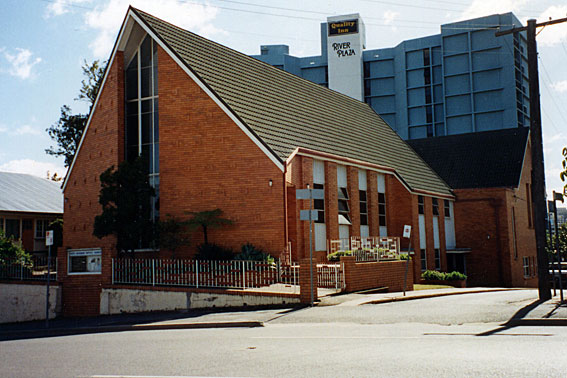
The former South Bank (South Brisbane) Baptist Church
[Photograph by Howard Baker (1990s)]

The former South Bank (South Brisbane) Baptist Church
[Photograph by Howard Baker (1990s)]
Historical and Technical Documentation by Geoffrey Cox
© OHTA 2012, 2013 (last updated October 2013)
The congregation of the Baptist Church, South Brisbane, was established in 1872, representing one of the earliest outgrowths from the Wharf Street Baptist Church in the city. A Sunday School had been started here as early as 1857.1
A reed organ served in the period up to the mid 1960s, at which time a project was initiated to remodel the building. The reconstructed and remodeled church was opened and dedicated on 10 December 1966, including an organ chamber behind the central screen and cross at the front of the building.2
The building was demolished in the first half of 2013, when the congregation moved to a new centre in Woolloongabba.
First Organ.
The first organ for the remodeled church was built by H.W. Jarrott of Brisbane, himself a member of the congregation. It was opened on 15 April 1967, with the console placed beside the pulpit. This instrument followed the style of small organs built by Jarrott over the previous decade, comprising a single manual with pedals, and using direct electric action:
| MANUAL Lieblich Gedackt Dulciana Principal PEDAL Bourdon COUPLERS Manual to Pedal Manual Super Octave Manual Sub Octave |
8 8 4 16 |
Tremulant
Electric action
Detached stop-key console.3
The organ was enlarged to two manuals by Jarrott in 1971-72, retaining the original three-stop Swell Organ, and adding new Great and Pedal divisions derived by extension from two ranks. The enlarged instrument was opened and dedicated on 15 April 1972.
| GREAT Open Diapason Stop Diapason Principal Flute Flautino SWELL Lieblich Gedackt Dulciana Principal PEDAL Bourdon Principal Bass Flute Principal COUPLERS Swell to Pedal Swell to Great Swell Octave Swell Sub Octave Swell Octave to Great Swell Sub Octave to Great |
8 8 4 4 2 8 8 4 16 8 8 4 |
A B A B B B A B A |
[1967] [1967] [1967] |
Tremulant
Electric action
Detached stop-key console.4
Disaster struck when this instrument, along with the upper structure of the church and hall buildings, was destroyed by fire on the evening of 7 July 1982.
Second Organ.
The second organ had served in three previous locations before being installed in this church in 1984. It was built originally in 1927-28 by Whitehouse Bros of Brisbane for the City Congregational Church Hall, Adelaide Street, Brisbane, which was opened on 25 January 1928 to replace the former Wharf Street Congregational Church.
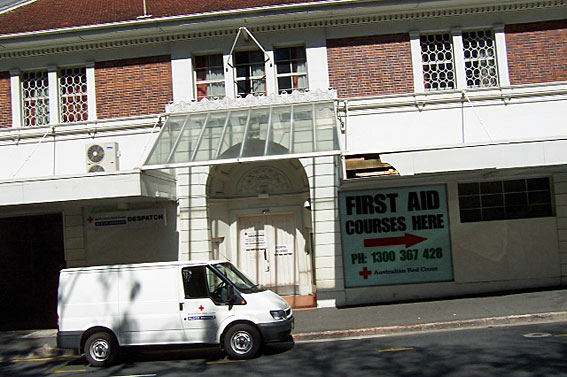
The former Congregational Church Hall, Adelaide Street
[Photograph by Noel Adsett (2005)
from the Edward Griffith (Archive) Room, St Andrew's Uniting Church, Brisbane]
The order for the instrument had been placed in April 1927, and it was officially opened on Sunday 27 May 1928.5

The 1928 Whitehouse Bros organ in the
Congregational Church Hall, Adelaide Street, Brisbane
Left to Right: Mr Joe Whitehouse (Jnr), Mr Joseph Whitehouse (Snr),
Rev. Percival Watson, and Mr Arch. H. West (organist)
[Photograph from The Brisbane Courier (23 May 1928), p. 18].7
The opening of the organ was proudly announced in The Brisbane Courier as follows:
Messrs. Whitehouse Brothers have just completed the installation of the new pipe organ in the City Congregational Church Hall. The specification of the new instrument was prepared by the church organist (Mr. Arch H. West, L.Mus.T.C.L.), in consultation with the builders. The instrument consists of three complete manuals, from CC to C, 61 notes, and 2-1/2 octaves of concave and radiating pedals, from CCC to F, 30 notes. The action is the builders' latest system of tubular pneumatic throughout, with a separate pallet to every pipe: this prevents robbing, ensuring perfect speech and repetition, whether the manuals are used singly or coupled. The keys are of the finest quality ivory, with ebony sharps. The console is detached and equipped with a complete system of controls, which includes 32 stop keys, and three pistons to great organ, three pistons to swell organ, and two pistons to choir organ. As is indicated by the specification, it represents the modern standard Whitehouse. At a private demonstration of the capabilities of the instrument, the organist (Mr Arch H. West) stated that the tone and action were excellent in every way. The organ will be officially opened and dedicated by the Rev. P. Watson, B.A., next Sunday, and a sacred concert will be held on Sunday afternoon. On Thursday, 31st instant, a concert will be given.
[The complete specification followed, as given below].8
Full details of the services and music for Sunday 27 May 1928 appeared in The Brisbane Courier on the previous day:
CITY CONGREGATIONAL CHURCH.
ADELAIDE-STREET, BETWEEN QUEEN AND WHARF STREETS.MINISTER, REV. PERCIVAL WATSON, B.A.
SERVICES IN DEDICATION OF NEW PIPE ORGAN.
MORNING, at 10 50, Organ Prelude by Mr. Arch H. West, L.Mus.T.C.L.
11, Devotions.ADDRESS TO CHILDREN by Sir Edward Sharp, President of British Section of World's Sunday School Association.
SERMON, "THE WAYS OF PRAISE," Rev. Percival Watson, B.A. Solo, "The Fold" (Squire), Miss Drusilia Smith. Anthem, "God is a Spirit" (Griffiths)
AFTERNOON, at 3 p.m., CHORAL SERVICE, by Choir and Soloists. Soloists: Contralto, Miss Hilda Cooper; tenor, Mr. Jack Land; violin, Mr. Morris Oran; organ, Mr. Arch. H. West. L.Mus.T.C.L. Organ: "Concert Overture in D" (Faulkes), "Cantilene Pastorale" (Guilmant), "Melodie" (Friml), "Nocturne" (D'Evry), "Finale" (Faulkes).
5 p.m., Young People's Fellowship. Tea, 6 p.m.
EVENING, at 7, Organ Prelude by Mrs. Harry Reeve and Mr. Arch. H. West, L.Mus.T.C.L.
7.30, Worship. Solos, "The Lost Chord" (Sullivan), Miss Dorrie Yarrow; "The People that Walked in Darkness" (Handel), Mr. J. E. England. SERMON, "THE SONS OF JUBAL," Rev. Percival Watson, B.A." Anthem, "The God of Abraham Praise" (Dudley Buck).
SPECIAL COLLECTIONS AT ALL SERVICES.9
Although a three-manual console was provided, the proposed four-stop Choir division was never added, and several other stops also were 'prepared for' at the console. In reality the instrument comprised 14 speaking stops spread over two manuals and pedals, with preparation at the console for additions as shown below:
| GREAT Open Diapason Dulciana Clarabella Principal Lieblich Flute [Fifteenth SWELL Open Diapason Lieblich Gedact Salicional Vox Celeste Gemshorn Harmonic Piccolo [Horn Oboe CHOIR [Dulciana [Rohr Flute [Harmonic Flute [Clarinet PEDAL [Open Diapason Bourdon Bass Flute COUPLERS Great to Pedal Swell to Pedal [Choir to Pedal] Swell to Great Swell to Choir [Choir to Great] Swell Super Swell Sub Swell Super to Great Swell Sub to Great |
8 8 8 4 4 2] 8 8 8 8 4 2 8] 8 8] 8] 4] 8] 16] 16 8 |
[prepared for] [prepared for] [prepared for] [prepared for] [prepared for] [prepared for] [prepared for] [prepared for] [prepared for] |
Swell Tremulant
Tubular-pneumatic action
Detached stop-key console
Compass: 61/30
Balanced swell pedal
Radiating concave pedalboard
3 thumb pistons to Great
3 thumb pistons to Swell
[2 thumb pistons to Choir] [prepared for].10
A report of 1927 stated that, while it was intended to use the organ initially in the Adelaide Street Hall, the long-term plan was to move it to a new church to be built on the site, at the same time providing additions to the organ.11
The first change to the initial plans came in January 1942, when the Adelaide Street premises were taken over for the duration of the war by the Department of Munitions and Supply. The congregation held services for some months at the Albert Street Methodist Church, but they moved in October 1942 to the former Presbyterian Church in Wickham Terrace, which they were able to rent from the Queensland Railways.12
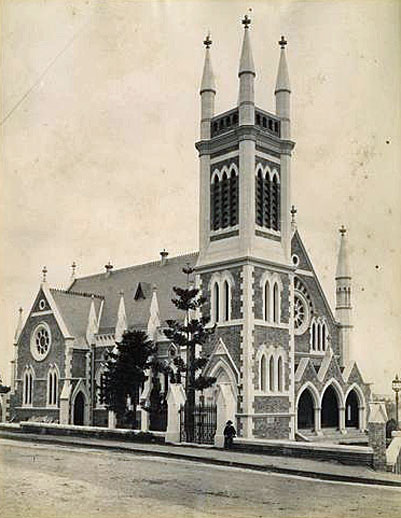
The old Wickham Terrace Presbyterian Church, c.1895,
utilised as the City Congregational Church, 1942-1959.
[Photograph: John Oxley Library, State Library of Queensland]
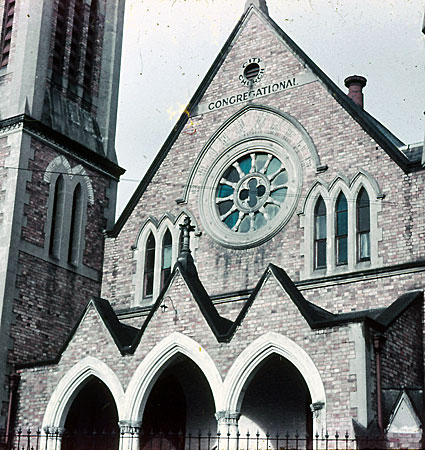
The Congregational (formerly Presbyterian) Church, Wickham Terrace, in 1959
[Photograph by Bryan Smith, supplied by David Vann (October 2013)]
New premises for the City Congregational Church were opened in Ann Street in August 1959, and the organ was moved yet again without any major change to its specification. In Ann Street, however, the console was further detached from the organ than previously, and the instrument was largely hidden behind a screen on the right-hand side at the front of the building, with tiered choir seating separating the console from the organ itself. This produced increased delay that led to the need to electrify the action more than a decade later.
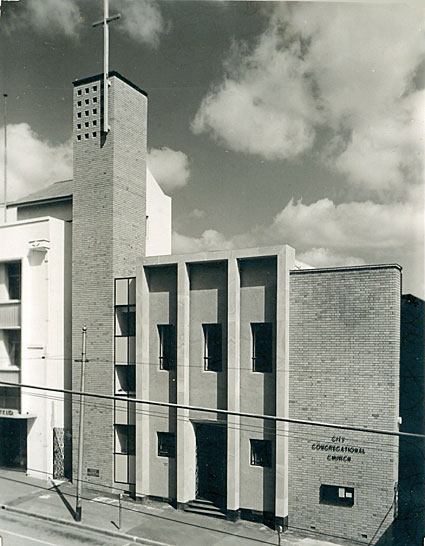
The new premises of the City Congregational Church
at 446 Ann Street, Brisbane
[Photograph by Eric Hutton (1959)
from the Edward Griffith (Archive) Room, St Andrew's Uniting Church, Brisbane]
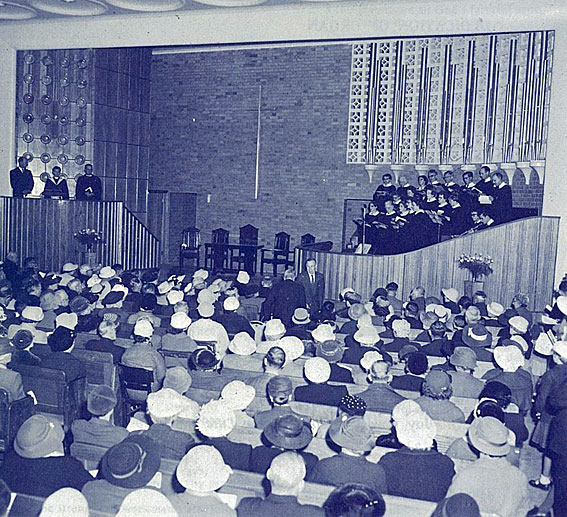
Interior of the City Congregational Church, Ann Street, Brisbane
[Photograph from Dedication Service leaflet
for the refurbished pipe organ (18 November 1973)]
The organ was electrified and enlarged in 1973 by Whitehouse Bros at a cost of $9000.14 Plans for adding the Choir division were abandoned at this time, and the console was reduced to two manuals. Three stops were added (Great Fifteenth 2ft & Mixture II; Swell Trompette 8ft), reflecting an attempt to modernise the tonal design, although they did not blend successfully with the existing instrument.15
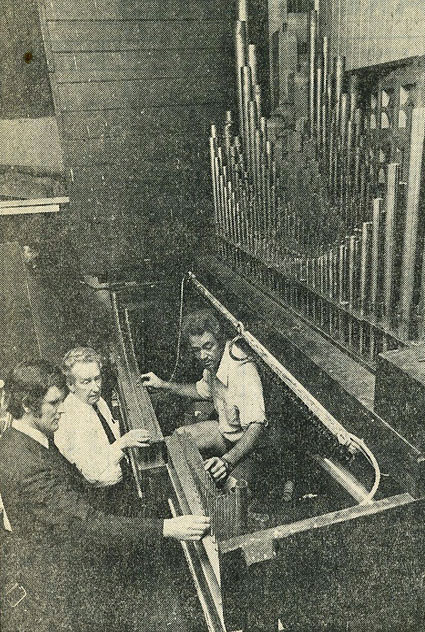
Features of the refurbished organ at the City Congregational Church
being explained by organ builder Mr. Kevin Whitehouse (right)
to David Vann (left) and the Rev. T. Rees Thomas
[Photograph from The Courier-Mail (10 November 1973)]
With the formation of the Uniting Church in Australia in 1977, the City Congregational Church became redundant, and the organ was purchased by the Baptist Church, South Brisbane, around 1983 to replace the previous instrument that had been destroyed by fire.
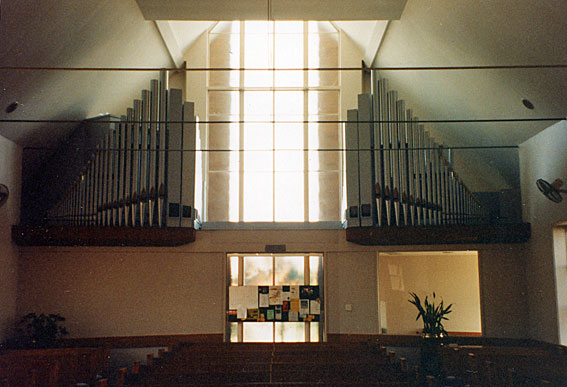

The 1928 Whitehouse Bros organ, rebuilt and installed
by H.W. Jarrott in the South Brisbane church in 1984
[Photographs by Howard Baker (1990s)]
In 1983-84, it was rebuilt with new electric action and installed in its present location over the church entrance foyer by H.W. Jarrott of Brisbane. Although some of the original stop nomenclature was changed in the current specification, all of the original 1928 Whitehouse ranks and soundboards were retained. The Great Open Diapason 8ft was removed from the chest to form part of the façade, along with pipes of the Pedal Bourdon 16ft, which was re-scaled for the building. The 1973 Great Mixture was removed, and three additional Pedal stops were provided, two by extension and the third utilizing a Keraulophone rank from an organ associated with W.J. Snow of Toowoomba around 1920.17
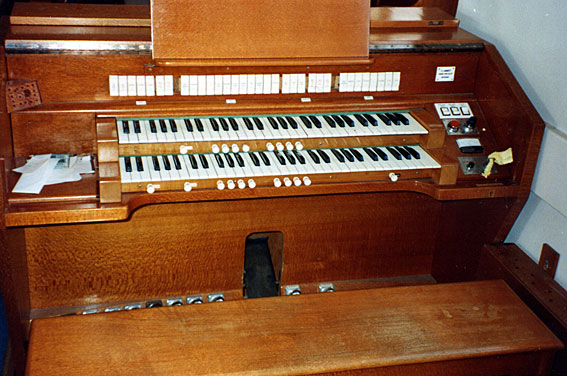
The 1972 Jarrott console from the first organ at the South Bank Baptist Church,
re-deployed by Jarrott in 1984 for the rebuilt Whitehouse Bros organ
[Photograph by Howard Baker (1990s)]
| GREAT Open Diapason Dulciana Clarabella Principal Flute Fifteenth SWELL Violin Diapason Gedackt Salicional Voix Celeste Gemshorn Harmonic Piccolo Oboe Harmonic Trumpet PEDAL Sub Bass Bass Flute Principal Fifteenth Violetta COUPLERS Great to Pedal Swell to Pedal Swell to Great Swell Octave Swell Unison Off Swell Sub Octave Swell Octave to Great Swell Sub Octave to Great |
8 8 8 4 4 2 8 8 8 8 4 2 8 8 16 8 8 4 4 |
A A A |
[1973] [1973] [1984] [1984] [1984, from an earlier instrument] |
Swell tremulant
Electro-pneumatic action
Detached stop-key console
Compass: 61/30
Balanced swell pedal
Radiating-concave pedalboard
8 pistons to Swell Organ
8 pistons to Great Organ
8 pistons to Pedal Organ
Full organ piston
General Cancel
Swell to Great reversible piston
Great to Pedal reversible piston
Swell to Pedal reversible piston
Brown & Arkley Capture System. 18
The congregation decided not to take the organ with them when they moved to Woolloongabba in the first half of 2013. It was removed from the building by Simon Pierce in February 2013 in the hope of finding it a new home.
___________________________________________________________________________
1 John E. White, A Fellowship of Service: A History of the Baptist Union of Queensland 1877-1977 (Brisbane: Baptist Union of Queensland, c.1977), pp. 42, 44, 60.
2 Commemorative Booklet, The Replaced Memorial Pipe Organ of our Church (South Brisbane Baptist Church, 20 May 1984), pp. 2-3.
3 Personal communication to G. Cox from H.W. Jarrott, c.1972.
4 Commemorative Booklet, op. cit.
5 David G. Vann, 'History of the City Congregational Church Organs' (pamphlet, c.1974) - based on information from The Yearbook of the City Congregational Church. [also published in Organ Society of Queensland Newsletter, vol. 1, no. 4 (July 1974), pp. 2-4]
6 Whitehouse Bros Ledger (1922-1940), p. 326.
7 A version of this photograph also appeared in The Telegraph (23 May 1928), p. 15.
8 The Brisbane Courier (23 May 1928), p. 16.
9 The Brisbane Courier (26 May 1928), p. 3; A full report of the dedication services appeared in The Brisbane Courier (28 May 1928), p. 23.
10 The specification noted by G. Cox, 1972, agrees entirely with that given in The Brisbane Courier (23 May 1928), p. 16.
11 David G. Vann, op. cit.
12 The Sunday-Mail (11 October 1942), p. 6.
13 Whitehouse Bros Ledger (1940-1954), p. 328.
14 The Courier-Mail (10 November 1973).
15 Specification noted by G. Cox, 1973.
16 City Congregational Church [Order of Service], 'Dedication Service of Restored Pipe Organ and Service of Music' (Sunday 18 November 1973 at 9.30 a.m.).
17 Personal communication to G. Cox from H.W. Jarrott, February 2012. W.J. Snow's organ was removed around 1930 to the Methodist Church, Oakey, and then around 1955 to the residence of Mrs A.E.A. Jarrott, Morningside. It was broken up around 1959.
18 Commemorative Booklet, op. cit., pp. 8-9. The Fifteenth 2ft stop on the Great Organ (1973) is not listed in the Commemorative Booklet.